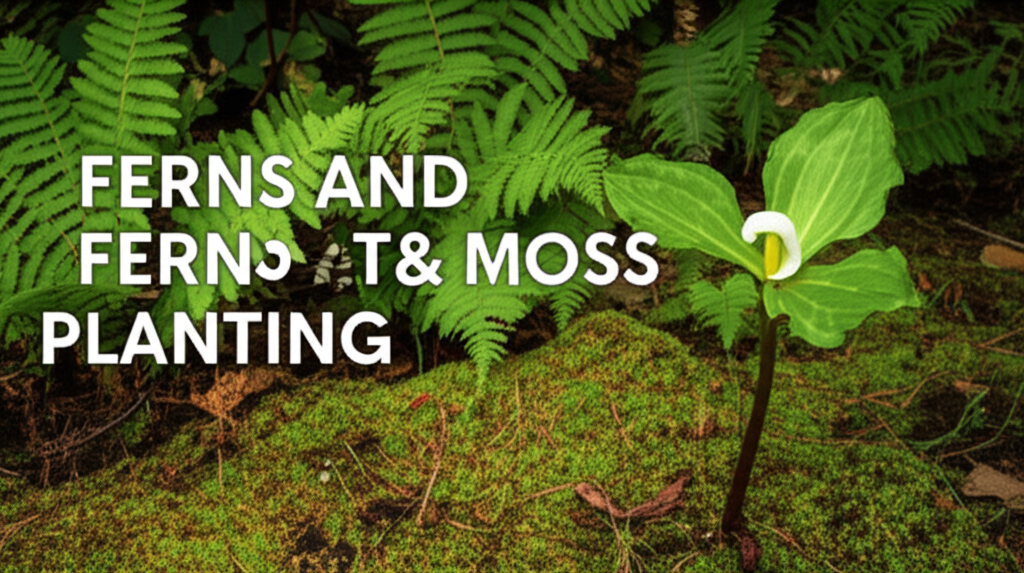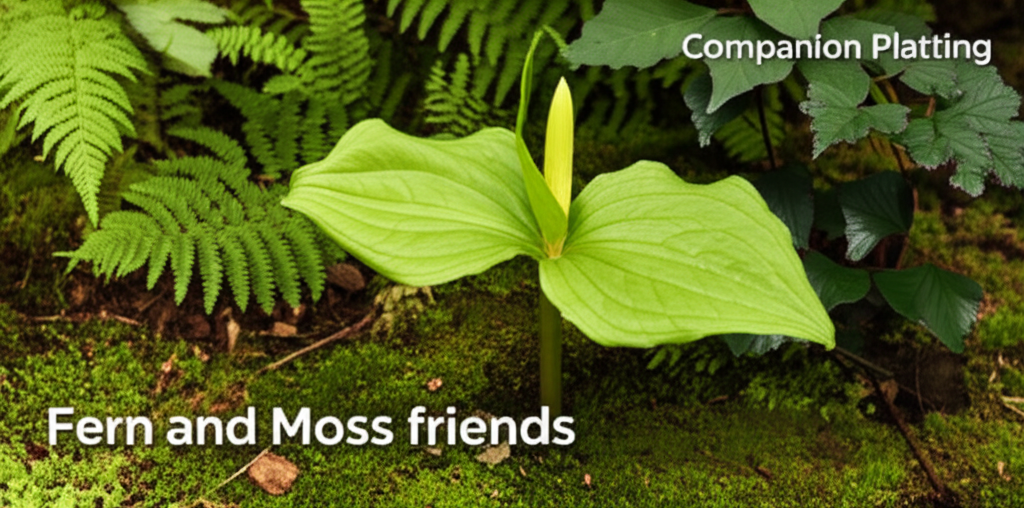The Enchanting World of Jack-in-the-Pulpit
Jack-in-the-Pulpit (Arisaema triphyllum) is a captivating woodland native renowned for its unique spathe and spadix, resembling a preacher within a pulpit. This intriguing plant thrives in the dappled shade of deciduous forests, requiring moist, well-drained soil rich in organic matter. Its distinctive structure, emerging in spring and developing vibrant red berries in late summer, makes it a focal point in any shaded garden. While its aesthetic appeal is undeniable, understanding the optimal conditions for its growth, particularly its need for specific companion plants, is crucial for successful cultivation. This article delves into the symbiotic relationships Jack-in-the-Pulpit forms with ferns and mosses, exploring how these woodland companions can create a flourishing, harmonious ecosystem in your shade garden.
Understanding the Needs of Jack-in-the-Pulpit
Before exploring companion planting, it’s essential to grasp the fundamental requirements of Jack-in-the-Pulpit. This native perennial typically grows 1-3 feet tall and prefers the filtered sunlight found beneath the canopy of mature trees. Its ideal habitat mimics the forest floor, characterized by:
- Moisture: Consistent, but not waterlogged, moisture is vital. The soil should remain damp, especially during dry spells.
- Soil Type: A rich, loamy soil with a good amount of organic material is preferred. Amendments like compost, leaf mold, or well-rotted manure will enhance soil structure and fertility.
- pH: Slightly acidic to neutral pH (around 5.5 to 7.0) is generally suitable.
- Shade: Deep shade or partial shade is crucial. Direct sunlight, especially in the afternoon, can scorch its delicate foliage.
- Dormancy: Jack-in-the-Pulpit enters a period of dormancy in late summer as its above-ground growth dies back. This is a natural process, and the plant will re-emerge the following spring.
The Synergy of Shade-Loving Companions
The success of growing Jack-in-the-Pulpit often lies in replicating its native woodland environment. Companion plants that share similar environmental needs can create a microclimate that benefits all species involved. Ferns and mosses are natural partners for Jack-in-the-Pulpit, offering not only aesthetic harmony but also practical advantages for the soil and surrounding plants.
Ferns: The Elegant Companions

Ferns are quintessential woodland plants, evoking a sense of ancient forests and serene beauty. Their diverse forms, from delicate fronds to bold, architectural shapes, provide an excellent textural contrast and visual depth to a shade garden. When paired with Jack-in-the-Pulpit, ferns contribute to a lush, naturalistic aesthetic while offering tangible benefits.
Why Ferns Make Great Companions
Ferns share many of the same environmental preferences as Jack-in-the-Pulpit, making them ideal planting partners. Their presence can help maintain the soil moisture and humidity that Jack-in-the-Pulpit requires.
- Soil Moisture Retention: The dense root systems of many fern species help to retain soil moisture, preventing the soil from drying out too quickly, which is beneficial for Jack-in-the-Pulpit, especially during its active growing season.
- Shade Provision: Taller ferns can provide additional shade for the base of Jack-in-the-Pulpit plants, protecting them from harsh sunlight, particularly in the early spring before deciduous trees fully leaf out.
- Nutrient Cycling: As ferns shed their fronds, they contribute to the organic matter in the soil, enriching it over time, which in turn benefits Jack-in-the-Pulpit.
- Pest Deterrence (Indirect): A healthy, diverse planting can often deter pests by supporting beneficial insects and creating a more resilient ecosystem.
- Aesthetic Appeal: The varied textures and shades of green offered by ferns create a visually stunning backdrop and complementary foliage for the unique bloom of Jack-in-the-Pulpit.
Recommended Fern Varieties for Companion Planting
Several fern species are particularly well-suited to growing alongside Jack-in-the-Pulpit, thriving in similar conditions.
| Fern Species | Height | Light Preference | Soil Preference | Key Characteristics |
|---|---|---|---|---|
| Ostrich Fern (Matteuccia struthiopteris) | 3-6 feet | Partial to full shade | Moist, rich soil | Large, feathery fronds; spreads by rhizomes |
| Christmas Fern (Polystichum acrostichoides) | 1-3 feet | Partial to full shade | Moist, well-drained soil | Evergreen fronds; hardy and adaptable |
| Lady Fern (Athyrium filix-femina) | 1-3 feet | Partial to full shade | Moist, humus-rich soil | Delicate, lacy fronds; graceful appearance |
| Maidenhair Fern (Adiantum pedatum) | 1-2 feet | Partial shade | Moist, acidic, humus-rich soil | Distinctive fan-shaped leaflets on black stems |
| Cinnamon Fern (Osmundastrum cinnamomeum) | 2-4 feet | Partial to full shade | Moist, acidic soil | Distinguished by cinnamon-colored fertile fronds in spring |
When selecting ferns, consider their mature size and growth habit. Spreading ferns like Ostrich Fern can be quite vigorous and may require containment if space is limited. Evergreen ferns like Christmas Fern provide year-round interest, even when Jack-in-the-Pulpit is dormant.
Mosses: The Ground-Covering Charmers
Mosses, with their velvety texture and vibrant green hues, are the unsung heroes of the woodland floor. They thrive in damp, shady environments, creating a soft, natural carpet that complements the emerging foliage of woodland plants. Integrating mosses into a Jack-in-the-Pulpit garden enhances the overall atmosphere and provides crucial benefits.
The Role of Mosses in a Jack-in-the-Pulpit Ecosystem
Mosses are more than just ground cover; they play an active role in maintaining a healthy microclimate suitable for Jack-in-the-Pulpit.
- Moisture Regulation: Mosses are incredibly effective at absorbing and retaining moisture. They act like a sponge, keeping the soil surface consistently damp, which is vital for Jack-in-the-Pulpit’s root system, especially during dry periods.
- Erosion Control: Their dense, fibrous structure helps to bind the soil, preventing erosion, particularly on slopes or areas with light foot traffic.
- Temperature Moderation: By covering the soil, mosses help to insulate the roots of plants, keeping them cooler in summer and slightly warmer in winter.
- Weed Suppression: A thick mat of moss can effectively suppress the growth of unwanted weeds, reducing the need for manual weeding and competition for resources.
- Aesthetic Harmony: The soft, undulating texture of moss provides a naturalistic and serene ground cover that perfectly complements the structural form of Jack-in-the-Pulpit and the graceful fronds of ferns.
Cultivating and Encouraging Moss Growth
Achieving a lush moss garden requires mimicking the conditions where mosses naturally flourish.
- Shade: Mosses, like Jack-in-the-Pulpit, require shade. Direct sunlight will quickly dry out and kill moss.
- Moisture: Consistent moisture is key. While mosses absorb water from the air, they need damp soil to thrive. Regular watering, especially during dry spells, is essential.
- Acidic Soil: Many moss species prefer slightly acidic soil conditions, which also suits Jack-in-the-Pulpit.
- Low Nutrient Soil: Unlike many vascular plants, mosses do not require rich soil and can thrive in nutrient-poor environments. This makes them excellent companions for plants that prefer less fertile ground.
- Surface: Mosses can grow on soil, rocks, and decaying wood, all of which are common in woodland settings.
Types of Mosses for Shade Gardens
While many moss species can be encouraged, some are more readily available or perform better in garden settings.
- Sheet Moss (Hypnum spp.): Forms large, flat mats and is very effective for ground cover.
- Cushion Moss (Leucobryum glaucum): Forms dense, rounded mounds, adding a textural element.
- Hair Cap Moss (Polytrichum commune): Grows upright and can create a more vertical texture.
Encouraging moss can involve transplanting healthy patches from shaded, moist areas (responsibly and with permission, of course) or using moss “slurries” – a mixture of moss, buttermilk, and water applied to suitable surfaces.
Creating a Harmonious Woodland Microclimate
The successful integration of Jack-in-the-Pulpit, ferns, and mosses goes beyond mere aesthetic arrangement. It’s about creating a self-sustaining, balanced ecosystem that mimics a natural woodland. This approach benefits not only the plants but also simplifies garden maintenance.
Planting Strategies for Optimal Growth
When planting these woodland natives together, consider their mature sizes and growth habits to avoid overcrowding.
- Site Selection: Choose a location that receives dappled shade throughout the day, with protection from harsh winds.
- Soil Preparation: Amend the soil with plenty of organic matter, such as compost, leaf mold, and aged manure. Ensure good drainage, as Jack-in-the-Pulpit and many ferns dislike waterlogged conditions.
- Planting Depths: Plant Jack-in-the-Pulpit corms about 3-4 inches deep. Ferns should be planted at a depth similar to their nursery pot, ensuring the crown is at or slightly above soil level.
- Spacing: Allow adequate space for each plant to reach its mature size. Consider the spreading habits of ferns like Ostrich Fern.
- Moss Integration: After planting, establish moss in the areas between the ferns and Jack-in-the-Pulpit. This can be done by laying moss patches or applying a slurry.
- Mulching: A light layer of organic mulch, such as shredded bark or pine needles, can help retain moisture and suppress weeds, further benefiting all plants.
Benefits of Companion Planting Jack-in-the-Pulpit with Ferns and Mosses
The symbiotic relationship between these plants offers numerous advantages for the gardener.
| Benefit | Description |
|---|---|
| Enhanced Soil Moisture | Ferns and mosses help retain soil moisture, providing a consistent water source for Jack-in-the-Pulpit. |
| Improved Soil Structure | Decomposing organic matter from fern fronds and moss contributes to nutrient-rich, well-structured soil. |
| Natural Weed Suppression | Mosses create a dense ground cover that outcompetes weeds, reducing the need for manual weeding. |
| Temperature Regulation | The ground cover provided by ferns and mosses insulates plant roots from extreme temperature fluctuations. |
| Aesthetic Appeal | The varied textures and shades of green create a beautiful, naturalistic woodland garden that is visually captivating throughout the seasons. |
| Reduced Maintenance | A balanced ecosystem with well-chosen companions often requires less intervention in terms of watering, fertilizing, and weeding. |
Potential Challenges and Solutions
While generally beneficial, there can be a few considerations when companion planting.
- Overcrowding: Fast-spreading ferns might eventually shade out or compete with younger Jack-in-the-Pulpit plants. Regular monitoring and thinning of ferns may be necessary.
- Drainage Issues: While moisture retention is good, excessive waterlogging can still be detrimental. Ensure the planting area has adequate drainage, especially if you have heavy clay soil.
- Pest and Disease Spread: While a healthy ecosystem is more resilient, dense plantings can sometimes provide habitat for pests or diseases. Good air circulation and prompt removal of any diseased foliage are important.
Conclusion: Cultivating a Thriving Shade Garden
Jack-in-the-Pulpit, with its unique botanical charm, finds its ideal setting when nestled amongst the enduring beauty of ferns and the soft embrace of moss. By understanding and replicating the natural conditions of its woodland habitat, gardeners can foster a thriving, self-sustaining microclimate. The synergistic relationship between these plants not only enhances the visual appeal of a shade garden, creating a tapestry of greens and textures, but also provides practical benefits such as improved soil moisture, nutrient cycling, and natural weed suppression. Careful planning and thoughtful selection of companion ferns and mosses will ensure that your Jack-in-the-Pulpit enjoys optimal growth and contributes to a truly enchanting woodland retreat. Embrace the philosophy of naturalistic gardening, and let the quiet beauty of these shade-loving companions transform your garden into a captivating sanctuary.


